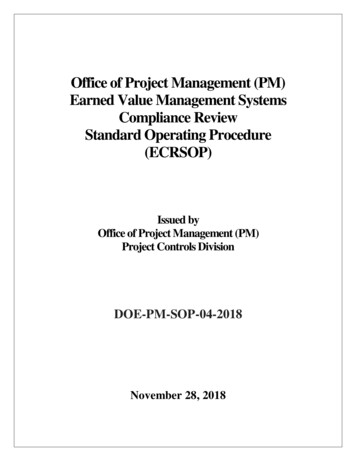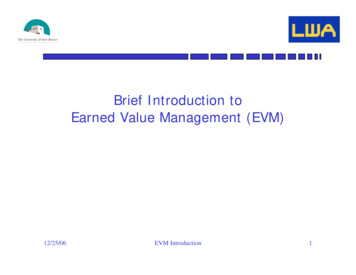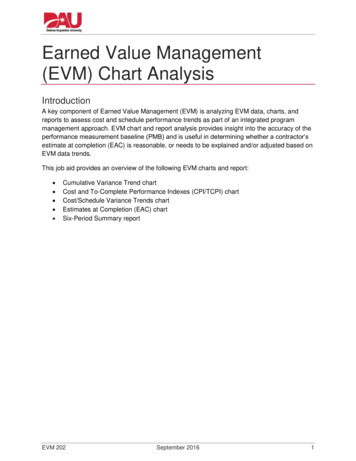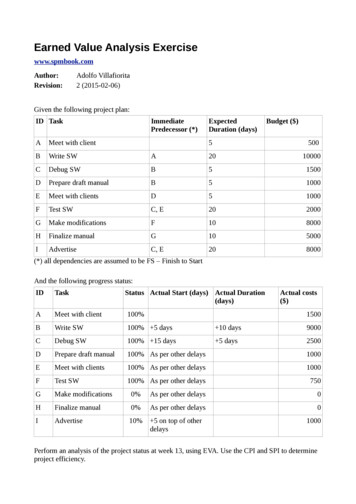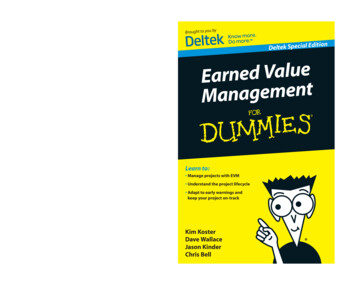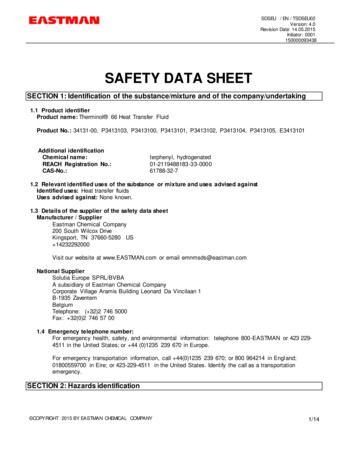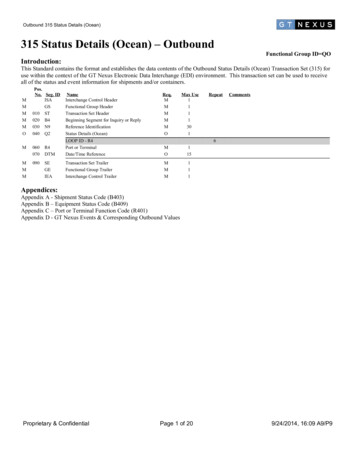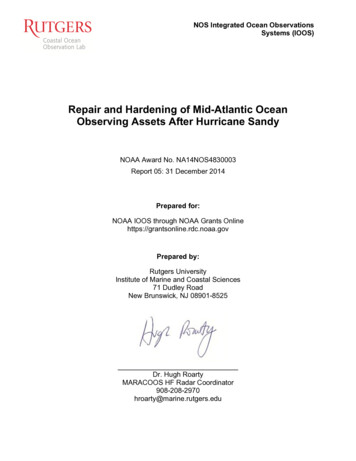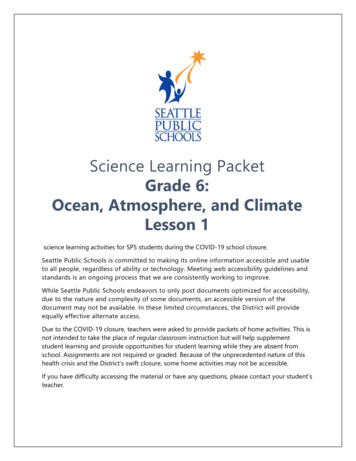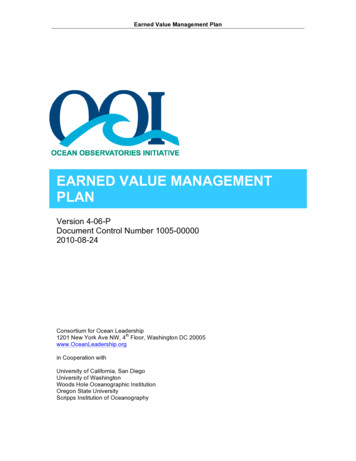
Transcription
Earned Value Management PlanEARNED VALUE MANAGEMENTPLANVersion 4-06-PDocument Control Number 1005-000002010-08-24Consortium for Ocean Leadershipth1201 New York Ave NW, 4 Floor, Washington DC 20005www.OceanLeadership.orgin Cooperation withUniversity of California, San DiegoUniversity of WashingtonWoods Hole Oceanographic InstitutionOregon State UniversityScripps Institution of Oceanography
Earned Value Management PlanDocument Control SheetVersion4-06-PDescriptionPublic versionNote: This document has been edited to remove information that is considered confidentialand/or sensitive to ongoing or future financial negotiations for OOI procurements. Informationremoved has been replaced by the insertion of “[redacted]”.Ver 4-06-P1005-00000i
Earned Value Management PlanTable of Contents123Introduction . 11.1Document Purpose . 11.2Document Audience . 1Earned Value Management . 22.1ANSI 748-B EVMS Standard . 22.2Work Breakdown Structure (WBS). 22.3Work Breakdown Structure Dictionary (WBS Dictionary). 32.4Integrated Master Schedule (IMS) . 32.5Control Account (CA) . 32.6Work Package (WP). 32.6.1 Work Packages – Discrete . 32.6.2 Work Packages – Level of Effort (LOE) . 42.7Task . 42.8Performance Measurement Baseline (PMB). 42.9Budgeted Cost for Work Scheduled (BCWS). 42.10Budgeted Cost for Work Performed (BCWP) . 42.11Actual Cost of Work Performed (ACWP) . 42.12Estimate to Complete (ETC) . 52.13Budget at Complete (BAC) . 52.14Estimate at Complete (EAC) . 52.15Earned Value Methodology Metrics . 52.16Format 1 Cost Performance Report (CPR Format 1) . 52.17Format 5 Cost Performance Report (CPR Format 5) . 62.18Over Target Baseline (OTB) . 62.19Re-Planning Techniques . 62.20Bill of Materials (BoM) . 6OOI EVM Policies . 73.1EVM Process Area: Organization . 73.1.1 OOI EVM Policies – WBS. 73.1.2 OOI EVM Policies – Process . 73.1.3 OOI EVM Policies - Integration. 73.2EVM Process Area: Planning, Scheduling & Budgeting . 83.2.1 OOI EVM Policies – Planning . 83.2.2 OOI EVM Policies – Scheduling . 83.2.3 OOI EVM Policies – Budgeting . 93.3EVM Process Area: Accounting . 93.3.1 OOI EVM Policies – Actual Costs. 93.3.2 OOI EVM Policies – Estimated Costs. 103.3.3 OOI EVM Policies – Material Actual Costs . 103.4EVM Process Area: Analysis . 103.4.1 OOI EVM Policy – Analysis . 103.4.2 OOI EVM Policy – Earning Value . 113.4.3 OOI EVM Policy – Estimates-to-Complete . 113.4.4 OOI EVM Policy – Reporting . 11Ver 4-06-P1005-00000ii
Earned Value Management Plan3.5EVM Process Area: Revisions & Data Maintenance. 12OOI EVMS Roles & Responsibilities. 134.1OOI Project Manager . 134.2IO Project Manager . 134.3OOI Master Scheduler . 134.4IO Financial Analyst . 134.5IO Scheduler . 144.6IO EV Manager . 144.7IO Control Account Manager. 145 OOI Earned Value Management Infrastructure . 155.1Microsoft Project Server . 175.2Microsoft Project Professional. 175.3OOI Cost Book . 175.4Deltek Cobra . 175.5forProject . 175.5.1 Update forProject. 175.5.2 Export forProject . 185.6IO Accounting Systems . 185.7Deltek wInsight . 185.8Software Components by Role . 185.9Future State Consideration . 195.9.1 Cost Book . 195.9.2 Cobra v5.0 . 196 OOI EVM Processes . 206.1OOI Baseline Development Process. 206.1.1 OOI Baseline Development Process . 206.1.2 OOI Baseline Development Process (Planned Evolution) . 216.2OOI EVM Schedule Status Update Process . 226.3OOI EVM Cost Update Process . 23OOI EVM Plan Appendices . 1Appendix A-1:OOI Resource Categories . 1Appendix A-2:Actual Cost (ACWP) Transaction File . 2Actual Cost (ACWP) Transaction File Definition . 2Actual Cost (ACWP) Transaction File Considerations . 2Resource Category Consideration . 3COBRA Resource Breakdown Structure . 4Actual Cost (ACWP) Transaction File Example . 5Actual Cost (ACWP) Transaction File Reconciliations . 6Appendix A-3:OOI Labor Hour Reporting Requirement . 7OOI Labor Hour Report Example . 7OOI Labor Hour Report Considerations . 7Appendix A-4OOI Earned Value Management Reference Material . 8Appendix A-5Sample CPR Format 1 . 9Appendix A-6Sample CPR Format 5 . 10Appendix A-7OOI Program EV Variance Thresholds . 114Ver 4-06-P1005-00000iii
Earned Value Management Plan1Introduction1.1Document PurposeThe purpose of this document is to describe the OOI Earned Value Management System (EVMS)and how through the OOI EVMS Policies, it adheres to the intent of the ANSI/EIA 748-B Standardfor Earned Value Management Systems. The ANSI/EIA 748-B Standard is the EVMS guidancedocument for recipients of either Major Research Equipment and Facility Construction (MREFC)funds or American Recovery & Reinvestment Act (ARRA) funds. The OOI is a recipient of both.Recipients of MREFC funds are expected to implement Earned Value as outlined by the NationalScience Foundation document entitled Large Facilities Manual (May 2007 / NSF 07-38). TheLFM points to the Office of Management and Budget (OMB) document entitled Planning,Budgeting, Acquisition and Management of Capital Assets for guidance on Earned Value. Thisdocument is Part 7 of the OMB Circular A-11.Recipients of ARRA funds are also expected to implement Earned Value per Part 7 of the OMBCircular A-11. OMB Circular A-11 requires the use of earned value “or similar” performancebased management system and refers to ANSI-EIA 748 EVMS Standard for guidance andpolicies concerning Earned Value.The document includes: Introduction to Earned Value Management Statement of the OOI EVM Policies Description of the OOI EVM Roles and Responsibilities Description of the OOI EVM Infrastructure Description of key OOI EVM PoliciesThis document does not include implementing organization (IO) specific business processes thateach IO will need to follow in order to adopt the OOI Earned Value Management System. It is theresponsibility of each IO to define these business processes.1.2Document AudienceThe audience for this document is anyone involved in the planning, execution and monitoring ofthe OOI from the perspective of the OOI Earned Value Management System. The primaryaudience members are the National Science Foundation (NSF), the OOI Management team andthe Implementing Organizations.Implementing Organizations are best represented by the component of the OOI they represent: Program Management Office (PMO), Ocean Leadership Cyberinfrastructure (CI), University of California, San Diego Coastal and Global Scale Nodes (CGSN), Woods Hole Oceanographic Institution Regional Scale Nodes (RSN), University of Washington Education and Public Engagement (EPE), To be namedFrom the perspective of this document, the PMO is considered an implementing organization (IO)subject to the EVMS Guidelines. The OOI PMO is also considered the governing body of theOOI and the owner of the OOI Change Management process.Ver 4-06-P1005-00000Page 1 of 38
Earned Value Management Plan2Earned Value ManagementEarned Value Management (EVM) is a project management methodology for integration of cost,schedule and technical management. EVM provides enhanced visibility and analysis of programdata using quantitative and objective methodologies for performance measurement.The foundation of EVM is based upon the assignment of a "measurable value" of work that hasbeen planned and budgeted. The value of work is earned as progress is made against the Tasksin the baseline Integrated Master Schedule (IMS). Progress, or Earned Value (EV), can bequantified and used to measure two items; The amount of actual work accomplished to-date versus the amount of work planned tobe accomplished to-date. This yields an EVM schedule variance. The cost of the actual work accomplished to-date versus the budget associated with theamount of work accomplished to-date. This yields an EVM cost variance.EVM provides "early warning" indicators of potential project issues, enabling implementation ofcorrective actions to ensure an on-time, on-budget delivery of the desired end products orservices.The OOI EVM system will use the principles and software toolsets described within this documentto integrate the defined scope of work for the Ocean Observatories Initiative (OOI) program withits corresponding schedule and budget elements and to objectively measure progress.Familiarity with general EVM concepts is useful for reading this document and supportingdiscussion of the OOI EVM Policy. The concepts described in this section are not to beinterpreted as OOI EVM Policy.2.1ANSI 748-B EVMS StandardThe ANSI/EIA 748-B Standard incorporates best business practices for program managementsystems that have proven to provide strong benefits for program or enterprise planning andcontrol. Though originally targeted for the Department of Defense, the Standard has beenadopted by the Department of Energy and many other civilian government agencies.The Office of Management and Budget (OMB) circular A-11, Part 7 requires the use of the ANSI748-B EVMS standard on all 'major information technology (IT) investments and for major non ITcapital assets' as defined by each agency. This is usually based on the project size (in dollars) orrisk, and has been applied on projects as little as 5M, making Earned Value Management one offastest growing management disciplines in the industry."2.2Work Breakdown Structure (WBS)The Work Breakdown Structure (WBS) is a product-oriented hierarchical structure that allows fordecomposition and analysis of the effort or “work” required to produce an end product. The WBSidentifies all of the products (i.e., hardware, software, system engineering, etc.) from the top-levelcontract down to the lower level of manageable work elements.The WBS provides the framework within which management control points referred to as ControlAccounts, Work Packages and Planning Packages are positioned relative to the overall program.It is also the framework in which work is organized, Tasks are scheduled, resources arebudgeted, actual costs are tracked and performance is measured. Each item in the WBS has aunique identifier, usually referred to as a WBS number.Ver 4-06-P1005-00000Page 2 of 38
Earned Value Management Plan2.3Work Breakdown Structure Dictionary (WBS Dictionary)The Work Breakdown Structure Dictionary accompanies the WBS and includes narrativeinformation for each WBS element that includes a brief description of the work scope, requireddeliverables, a list of associated activities and a list of key milestones. It may also include theresponsible organization, start dates, end dates, required resources, and estimate of cost, chargenumber, quality requirements and technical references that facilitate the performance of the work.It can also include the entrance and exit criteria used for understanding the appropriateprerequisite and post-requisite Tasks associated with the WBS element.2.4Integrated Master Schedule (IMS)An Integrated Master Schedule (IMS) contains the logic network-based framework that providesthe basis for time-phasing and coordinating all program efforts and resources. The IMS typicallyreflects both baseline and current schedule data. The time phasing of Tasks and assignment ofnecessary Task resources within the IMS is critical to development of a PerformanceManagement Baseline (PMB) and successful implementation of EVM.An IMS consists of as many fully resource loaded project schedules as necessary to fullyrepresent the scope of an overall program. Cross project dependencies are defined to knit themultiple project schedules into a single cohesive IMS.2.5 Control Account (CA)A Control Account (CA) is a logical management control point to which program budgets(resource plans) and actual costs are summarized and compared to earned value formanagement control purposes and formal reporting to external entities such as the NationalScience Foundation.Control Accounts are comprised of one or more Work Packages or Planning Packages.2.6 Work Package (WP)A Work Package (WP) is a further subdivision of work effort below the Control Account. A WorkPackage consists of one or more Tasks that represent the work associated with delivery of one ormore products. A Work Package has the following characteristics: It represents units of work at levels where work is performed. It is clearly distinguished from all other Work Packages. It is assigned to a single organizational element (e.g., subcontractor). It has scheduled start and completion dates. It contains, as applicable, interim milestones representative of physical accomplishments. It has a budget expressed in terms of hours, direct dollars or other measurable unit(typically stemming from unit pricing of material).2.6.1Work Packages – DiscreteA discrete Work Package represents work culminating in the deliver of product. A Work Packagerepresenting discrete work is comprised of only Tasks that represent dis
Earned Value Management Plan EARNED VALUE MANAGEMENT PLAN Version 4-06-P Document Control Number 1005-00000 2010-08-24 Consortium for Ocean Leadership 1201 New York Ave NW, 4th Floor, Washington DC 20005 www.OceanLeadership.org in Cooperation with University of California, San Diego Univ
